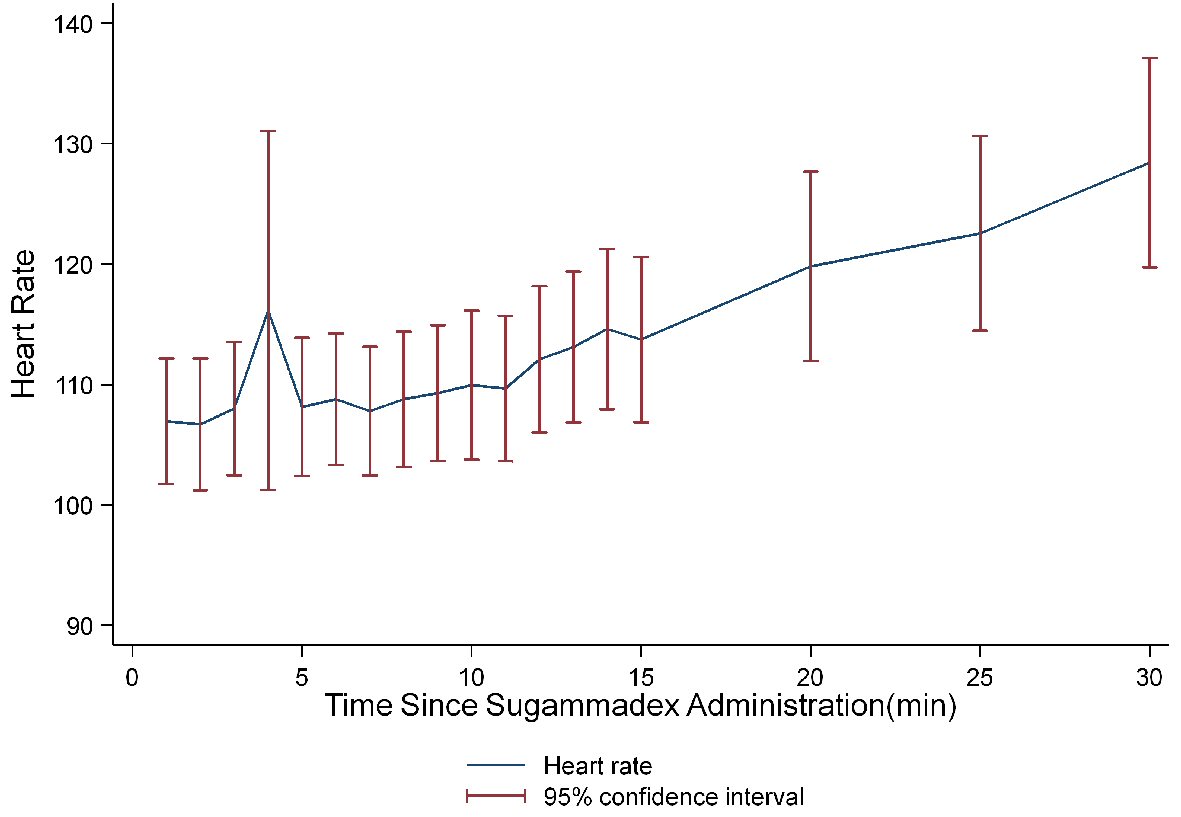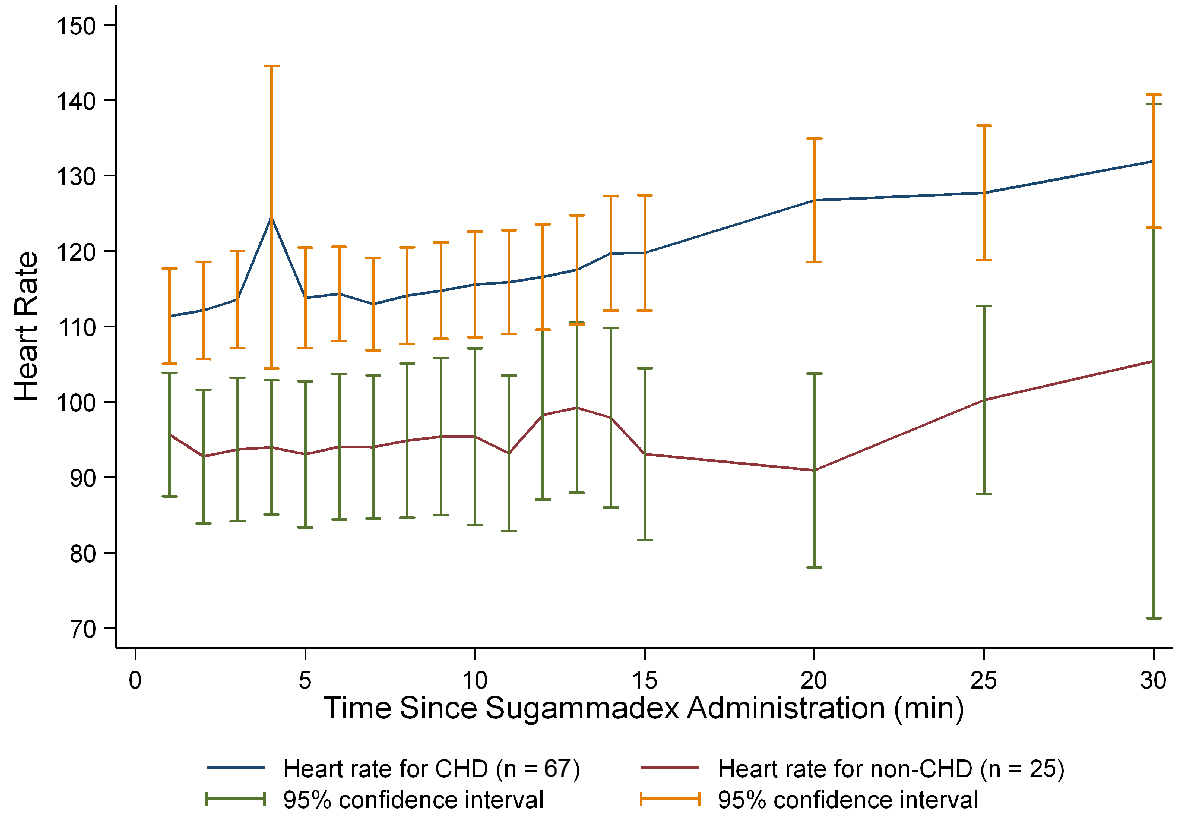
Figure 1. Average heart rate for the first 30 min following sugammadex administration (n = 92). Seven patients with bradycardia at baseline were eliminated.
| Cardiology Research, ISSN 1923-2829 print, 1923-2837 online, Open Access |
| Article copyright, the authors; Journal compilation copyright, Cardiol Res and Elmer Press Inc |
| Journal website http://www.cardiologyres.org |
Original Article
Volume 11, Number 5, October 2020, pages 274-279
Heart Rate Changes Following the Administration of Sugammadex to Infants and Children With Comorbid Cardiac, Cardiovascular, and Congenital Heart Diseases
Figures


Tables
| Patient | Definition of bradycardia for the patient (beats/min) | Baseline heart rate (beats/min) | Bradycardic at baseline | Lowest heart rate after sugammadex (beats/min) | Bradycardic after sugammadex | Absolute difference in heart rate from baseline (beats/min) |
|---|---|---|---|---|---|---|
| 1 | ≤ 61 | 56 | Yes | 57 | Yes | 1 |
| 2 | ≤ 92 | 91 | Yes | 87 | Yes | 4 |
| 3 | ≤ 82 | 73 | Yes | 73 | Yes | 0 |
| 4 | ≤ 87 | 87 | Yes | 87 | Yes | 0 |
| 5 | ≤ 113 | 110 | Yes | 106 | Yes | 4 |
| 6 | ≤ 108 | 91 | Yes | 90 | Yes | 1 |
| 7 | ≤ 66 | 71 | No | 62 | Yes | 9 |
| 8 | ≤ 66 | 69 | No | 56 | Yes | 13 |
| 9 | ≤ 61 | 79 | No | 46 | Yes | 33 |
| 10 | ≤ 82 | 84 | No | 79 | Yes | 5 |
| 11 | ≤ 113 | 118 | No | 106 | Yes | 12 |
| 12 | ≤ 108 | 109 | No | 107 | Yes | 2 |
| 13 | ≤ 77 | 82 | No | 71 | Yes | 11 |
| 14 | ≤ 57 | 73 | No | 53 | Yes | 20 |
| 15 | ≤ 108 | 135 | No | 76 | Yes | 59 |
| 16 | ≤ 61 | 70 | No | 44 | Yes | 26 |
| 17 | ≤ 61 | 99 | No | 51 | Yes | 48 |
| 18 | ≤ 108 | 110 | No | 108 | Yes | 2 |
| 19 | ≤ 66 | 68 | No | 64 | Yes | 4 |
| 20 | ≤ 82 | 83 | No | 79 | Yes | 4 |
| Variable | All (n = 99) | Bradycardia/no (n = 78) | Bradycardia/yes (n = 14) | P valueb |
|---|---|---|---|---|
| Date presented as n (%) or median (IQR). aSeven patients with bradycardia at baseline were eliminated from the bradycardia/yes versus bradycardia/ no comparison. bDifference between groups tested using Fisher’s exact test. cDifference between groups tested using Mann-Whitney U test. IQR: interquartile range; n: number. | ||||
| Gender, female | 41 (41) | 32 (41) | 4 (28.6) | 0.554 |
| Age (years) | 3 (0, 10) | 2.5 (0, 9) | 7.5 (0, 12) | 0.292c |
| Weight (kg) | 13.5 (6.5, 30.7) | 13.4 (6.6, 30.7) | 21.3 (6.3, 40.4) | 0.344c |
| Procedures | ||||
| Cardiac surgery | 45 (45.5) | 38 (48.7) | 4 (28.6) | 0.245 |
| Non-cardiac surgery | 5 (5.0) | 4 (5.1) | 1 (7.1) | 0.570 |
| Cardiac catheterization | 29 (29.3) | 23 (29.5) | 5 (35.7) | 0.754 |
| Electrophysiology study | 20 (20.2) | 13 (16.7) | 4 (28.6) | 0.283 |
| Initial sugammadex dose (mg/kg) | 3.9 (2.1, 4.0) | 3.9 (2.1, 4.0) | 2.7 (2.1, 3.9) | 0.243c |
| Baseline heart rate (beats/min) | 107 (84, 130) | 113 (91, 133) | 83 (71, 109) | 0.003c |
| Heart rate decrease (beats/min) | 4 (1, 11) | 4 (1, 8) | 12 (4, 26) | 0.006c |
| Characteristics | Odds ratio | 95% confidence interval | P value |
|---|---|---|---|
| aSeven patients with bradycardia at baseline were eliminated from multivariable regression analysis. | |||
| Female | 0.58 | 0.17, 1.99 | 0.383 |
| Age (years) | 1.06 | 0.96, 1.17 | 0.247 |
| Weight (kg) | 1.01 | 0.99, 1.04 | 0.413 |
| Initial sugammadex dose (mg/kg) | 0.67 | 0.40, 1.13 | 0.132 |
| Cardiac comorbid conditiona | All (n = 99) | Bradycardia/no (n = 78) | Bradycardia/yes (n = 14) |
|---|---|---|---|
| aSeven patients with bradycardia at baseline were eliminated from the bradycardia/yes versus bradycardia/no comparison. bAtrial septal defect, ventricular septal defect, patent ductus arteriosus, atrioventricular canal, tetralogy of Fallot, hypoplastic left heart syndrome, pulmonary atresia, coarctation of the aorta and truncus arteriosus. | |||
| Congenital heart diseaseb | 72 | 59 | 8 |
| Valvular heart disease (pulmonary or aortic stenosis) | 4 | 3 | 1 |
| Cardiomyopathy | 3 | 3 | 0 |
| Status post heart transplant | 3 | 2 | 1 |
| Arrhythmias | 15 | 9 | 4 |
| No other cardiac comorbidity | 2 | 2 | 0 |